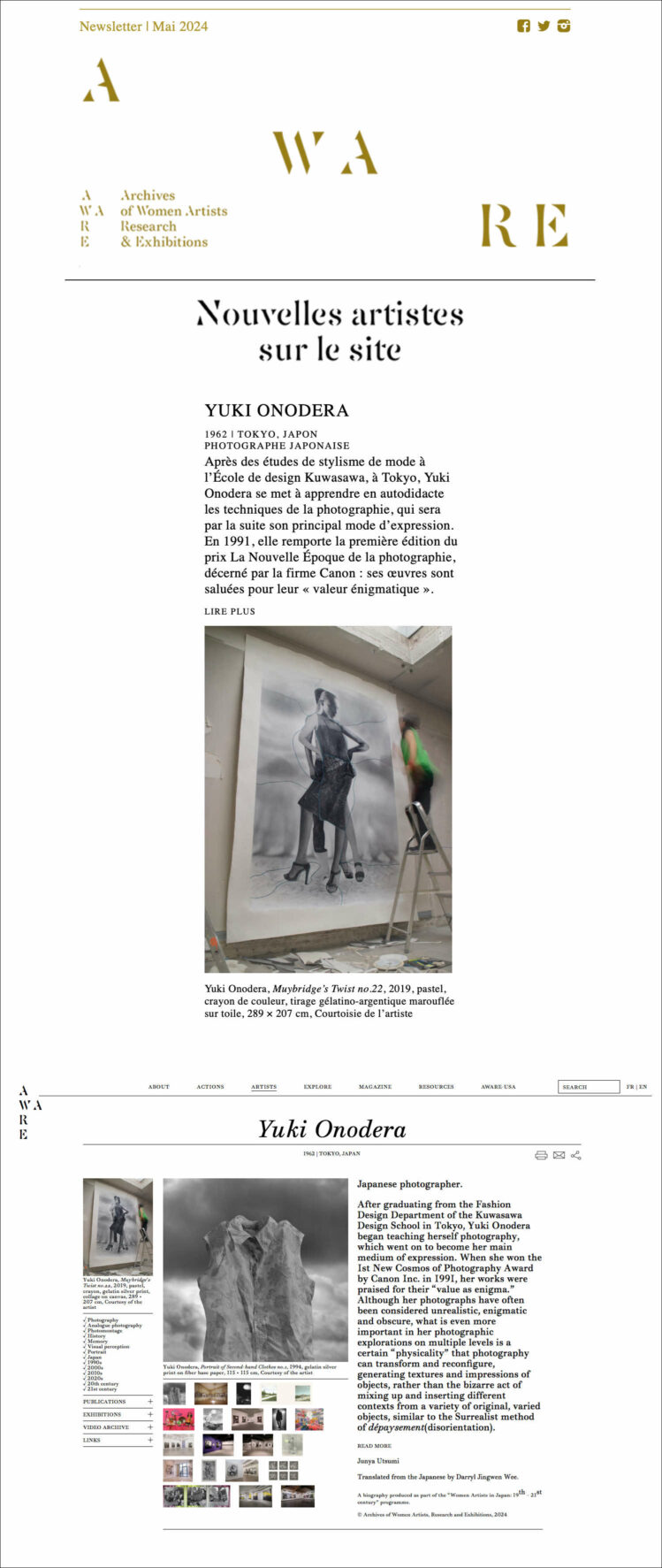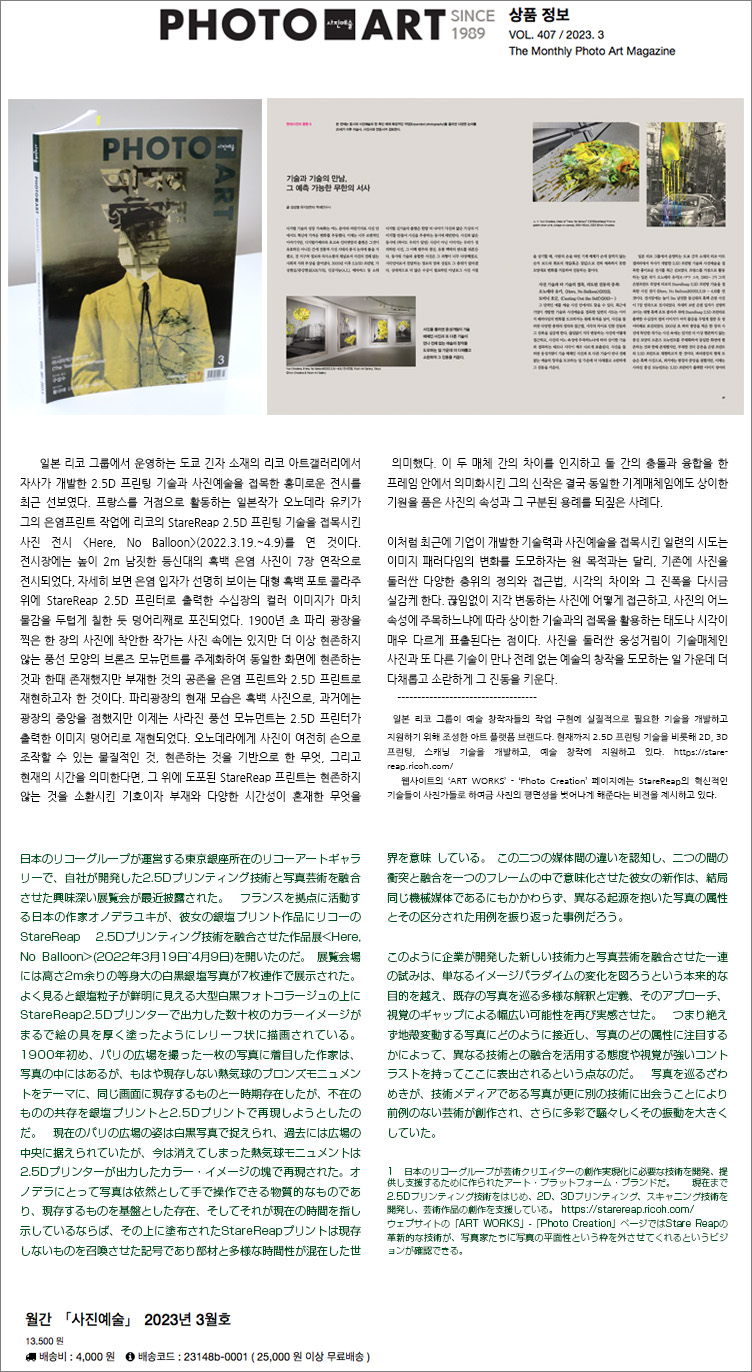AWARE : Archives of Women Artists, Research and Exhibitions
AWARE : Archives of Women Artists, Research and Exhibitions
Yuki Onodera
Japanese photographer.After graduating from the Fashion Design Department of the Kuwasawa Design School in Tokyo, Yuki Onodera began teaching herself photography, which went on to become her main medium of expression. When she won the 1st New Cosmos of Photography Award by Canon Inc. in 1991, her works were praised for their “value as enigma”. Although her photographs have often been considered unrealistic, enigmatic and obscure, what is even more important in her photographic explorations on multiple levels is a certain “physicality” that photography can transform and reconfigure, generating textures and impressions of objects, rather than the bizarre act of mixing up and inserting different contexts from a variety of original, varied objects, similar to the Surrealist method of dépaysement(disorientation).
When Y. Onodera moved to Paris in 1993, the solo exhibition of Christian Boltanski (1944–2021), Dispersion, was being held at Quai de la Gare, Paris. In the work from which the exhibition borrowed its title, Boltanski had piled up a large quantity of partially torn second-hand clothes as a monument to the Holocaust. When Y. Onodera went to see the work, she carried a bag to take away many of these clothes, thereby giving birth to her renowned work, Portrait of Second-hand Clothes (1994). This series of works is composed of second-hand clothes that seem to stand in front with the sky and floating clouds behind them. The grey tone covering the whole picture presents a sharp contrast between the front and back, evoking the presence of the person who is supposed to be wearing these clothes. In the front, the clear, tactile texture of the fabric evokes both the absence and presence of the person, while at the back, the blurred image and distant sky alludes to the majestic flow of time that extends beyond that person, or the immeasurable sense of time accumulated on that individual’s shoulders. As the artist remarked, the timing of the shooting for each piece required her to wait until she felt as if a figure had evaporated into the air. This process seeks to revitalise each person from these mass piles, as well as to use photography as an apparatus to evoke the textures of memory, even if unbeknownst to the viewer.
Combining different kinds of physicality into a picture is possible only if we know the image of the textures of things captured in photography: as Roland Barthes said, a photograph essentially points to and repeats something that “has been”, which comes across differently, as a “failure,” rather than depicting something as it seems. Y. Onodera continues to apply this methodology to many series. In How to Make a Pearl (2000–2001), a glass marble installed in a camera creates shadows in photography, making it seem as if a strange white object is floating above people gathering in the darkness, while in Liquid, TV and Insect (2002), an image of an insect collected from a TV broadcast is juxtaposed with another of some spilled, paint-like liquid that resembles the shadow of the insect. In Transvest (2002–on going), a photomontage of existing images taken from magazines and newspapers is turned into a silhouette through stage-like backlighting. Eleventh Finger (2006–on going) depicts a person’s face covered and hidden by papers perforated in a lace pattern that seems to have been attached through the photogram process, creating another photographic layer from the scene that was shot. In Study for “Image à la sauvette” (2015–on going), acrylic paint on a printed photo that seems to spill out from distorted plastic bottles is combined in a photograph whose transparent but existing bodies are only recognizable through reflections of lights.
In addition to these creative distortions of how photography usually operates, achieved by inserting different kinds of physicality into a picture, the size of the printed image in Y. Onodera’s work fulfils an important function, regardless of whether it is small or large a point demonstrated by Muybridge’s Twist (2014–on going). Alluding to the English photographer Eadweard Muybridge (1830–1904), who in the late 19th century captured the movements of running horses and walking people in serial photographs, Y. Onodera collaged various parts of human bodies and some of animals, creating an image in which a person seems to be dancing the twist. In a print on a larger scale than the human body, over 300 × 200 cm, the eerily blended parts create the impression of a twisted sculpture, rather than the sequential movements of a figure. When assembling images, she enlarges original images taken from fashion photos, and cuts and collages them in a similar size to the final product. The size of the outcome is significant in terms of how it imbues viewers with an overwhelming sense of power, as well as how another kind of physicality associated with photography affects the result in the process.
Y. Onodera continues to show new series in her recent solo shows, such as La clairvoyance du hasard in 2022 at Centre de la photographie de Mougins, France, and in the same year, Here, No Balloons at Ricoh Art Gallery, Tokyo. Her major solo exhibitions include Yuki Onodera, Décalages in 2015 at Maison Européenne de la photographie, Paris, Thousand Mirror in the Forest in 2014 at La Maison d’Art Bernard Anthonioz, Nogent-sur-Marne, Gravity-defying photography in 2011–2012 at Musée Nicéphore Niépce, Chalon-sur-Saône, Onodera Yuki: Into the Labyrinth of Photography in 2010 at the Tokyo Metropolitan Museum of Photography, and Onodera Yuki in 2010 at The Museum of Photography, Seoul.
She received the Award of the Ministry of Education and Culture, Japan, and the 27th Grand Prix of the Higashikawa Prize in 2011. Y. Onodera also won the Prix Niépce in 2006 and the 28th Ihei Kimura Award in 2003.Junya Utsumi
Translated from the Japanese by Darryl Jingwen Wee.
A biography produced as part of the “Women Artists in Japan: 19th – 21st century” programme.
© Archives of Women Artists, Research and Exhibitions, 2024









